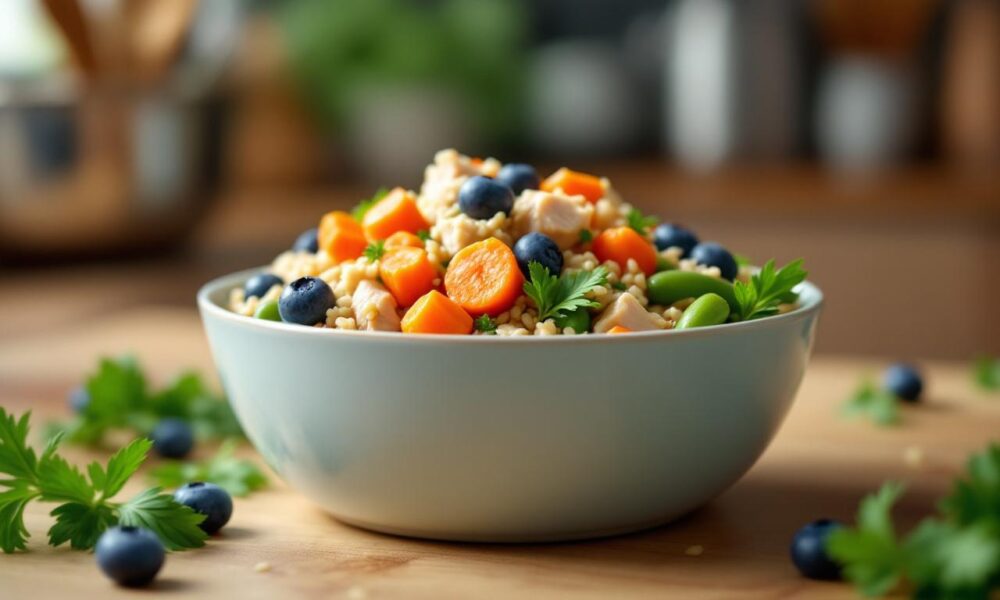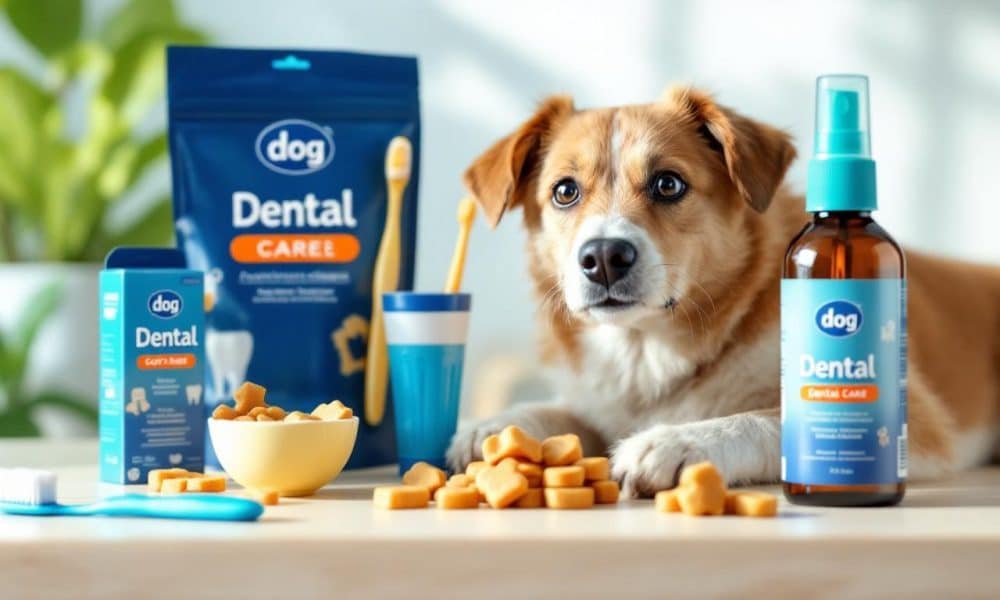
“This post contains affiliate links, and I will be compensated if you make a purchase after clicking on my links.”
At DogingtonPost, we believe that holistic dog nutrition is the key to a healthier, happier canine companion.
Natural feeding goes beyond just filling your dog’s bowl; it’s about providing a balanced, species-appropriate diet that supports overall well-being.
In this guide, we’ll explore the essential components of a holistic diet and show you how to transition your furry friend to a more natural way of eating.
What Is Holistic Dog Nutrition?
A Comprehensive Approach to Canine Well-being
Holistic dog nutrition takes a complete approach to feeding. It considers your dog’s entire well-being, not just their basic caloric needs. This method focuses on providing a diet that closely mimics what dogs would eat in nature, supporting both their physical and mental health.
The Power of Natural Ingredients
A natural diet for dogs typically includes high-quality, unprocessed ingredients. This means real meats, organs, bones, fruits, and vegetables. Potential benefits of such diets include shinier coats, healthier skin, cleaner teeth, higher energy levels, and smaller stools.
Balancing Act: The Right Nutrients
Balanced nutrition plays a key role in holistic feeding. This involves providing the right proportions of proteins, fats, carbohydrates, vitamins, and minerals. The Association of American Feed Control Officials recommends that adult dog food contain a minimum of 18% protein and 5.5% fat. However, many holistic practitioners suggest higher protein levels (often around 30%) to better match a dog’s ancestral diet.
Tailoring Diet to Individual Needs
One size doesn’t fit all in holistic nutrition. Factors like age, breed, activity level, and health conditions influence the ideal diet. For instance, working dogs may require diets with up to 30% fat content for sustained energy, while less active dogs might need only 10-15% fat to maintain a healthy weight.
The Impact on Health and Longevity
Embracing holistic nutrition doesn’t just feed your dog – it nourishes them from the inside out. This approach can potentially reduce vet bills and extend their lifespan. However, it’s important to note that transitioning to a new diet should happen gradually and under the guidance of a veterinary professional. This ensures that the new diet meets all of your dog’s nutritional needs.
As we move forward, let’s explore the essential components that make up a natural dog diet. Understanding these key elements will help you make informed decisions about your furry friend’s nutrition.
Essential Components of a Natural Dog Diet
High-Quality Protein: The Foundation of Canine Health
High-quality protein forms the cornerstone of a natural dog diet. Dogs thrive on animal proteins, which their bodies efficiently digest and utilize. Try to include lean meats (chicken, turkey, beef), fish (salmon, sardines), and eggs in your dog’s meals. These provide essential amino acids necessary for muscle development, immune function, and overall health.

A study revealed that overweight dogs fed a diet with a higher percentage of calories from protein lost more fat and retained more lean body mass while moving closer to their ideal weight.
Healthy Fats: Fueling Energy and Promoting Coat Health
Fats play a vital role in dog nutrition. They provide a concentrated source of energy and maintain healthy skin and a shiny coat. Include sources of healthy fats like fish oil, flaxseed oil, and coconut oil in your dog’s diet.
The National Research Council recommends that adult dogs consume at least 5.5% of their diet as fat, but active dogs may need up to 20%. Balance remains key – excessive fat can lead to obesity, while insufficient fat can result in a dull coat and dry skin.
Nutrient-Rich Fruits and Vegetables: Nature’s Multivitamins
While dogs don’t require carbohydrates like humans, fruits and vegetables provide essential vitamins, minerals, and fiber. Incorporate nutrient-dense options like blueberries, sweet potatoes, and leafy greens.
A study suggested that consumption of certain vegetables may prevent or slow the development of transitional cell carcinoma in Scottish Terriers. However, always introduce new foods gradually and in moderation.
Beneficial Supplements: Filling Nutritional Gaps
Even with a carefully planned natural diet, some dogs may benefit from supplements. Probiotics can support digestive health, while omega-3 fatty acids from fish oil can reduce inflammation and support cognitive function in older dogs.
When considering supplements, always consult with a veterinarian to ensure they suit your dog’s specific needs. Not all dogs require supplements, and over-supplementation can harm your pet’s health.
Now that we’ve explored the essential components of a natural dog diet, let’s discuss how to transition your furry friend to this healthier way of eating in the next section.
How to Transition Your Dog to a Holistic Diet
Start with Small Changes
Replace 25% of your dog’s current food with the new holistic option. Mix the two foods thoroughly to prevent your dog from picking out only the new bits. Maintain this ratio for 2-3 days, closely observe your dog’s reaction. If all goes well, increase the new food to 50% for another 2-3 days, then to 75% for 2-3 more days, before finally transitioning to 100% holistic food.
Watch for Signs of Digestive Upset
During the transition, look out for any signs of digestive discomfort. These may include vomiting, diarrhea, or loss of appetite. If you notice any of these symptoms, slow down the transition process. A study published in the Journal of Animal Science found that abrupt dietary changes can lead to significant alterations in the gut microbiome (potentially causing digestive issues).
Adjust Portions Based on Your Dog’s Needs
Holistic diets often have different caloric densities compared to conventional dog food. You may need to adjust portion sizes to maintain your dog’s ideal weight. The Association for Pet Obesity Prevention reports that 59% of dogs in the United States are overweight or obese (highlighting the importance of proper portion control).

Monitor your dog’s weight weekly during the transition and adjust portions as needed. A general rule of thumb is to feed adult dogs about 2-3% of their ideal body weight daily, but this can vary based on age, activity level, and health status.
Seek Professional Guidance
While you can transition to a holistic diet at home, it’s always wise to consult with a veterinary nutritionist. They can provide personalized advice based on your dog’s specific needs and help you create a balanced meal plan. The American College of Veterinary Nutrition offers a directory of board-certified veterinary nutritionists who can provide expert guidance.
Every dog is unique, and what works for one may not work for another. Be prepared to make adjustments as you go along, always prioritize your dog’s health and well-being throughout the transition process.
Final Thoughts
Holistic dog nutrition represents a powerful approach to enhance your canine companion’s overall health and well-being. This method of feeding supports optimal bodily functions, boosts immune systems, and can potentially extend our furry friends’ lifespans. The long-term benefits include improved digestion, healthier skin and coat, increased energy levels, and better weight management.

We at DogingtonPost commit ourselves to help you make informed dietary choices for your canine companion. Our comprehensive resources offer the latest insights on dog nutrition, health tips, and expert advice to guide you on your journey towards holistic pet care. Professional guidance ensures your dog’s new diet meets all nutritional requirements.
Holistic dog nutrition is more than just a trend; it’s a commitment to provide the best possible care for our four-legged family members. The path to optimal canine health starts with what we put in their bowls (choose wisely, and your dog will thank you with years of joyful companionship). Understanding and applying the principles of natural feeding thoughtfully can help our dogs lead healthier, happier, and potentially longer lives.







